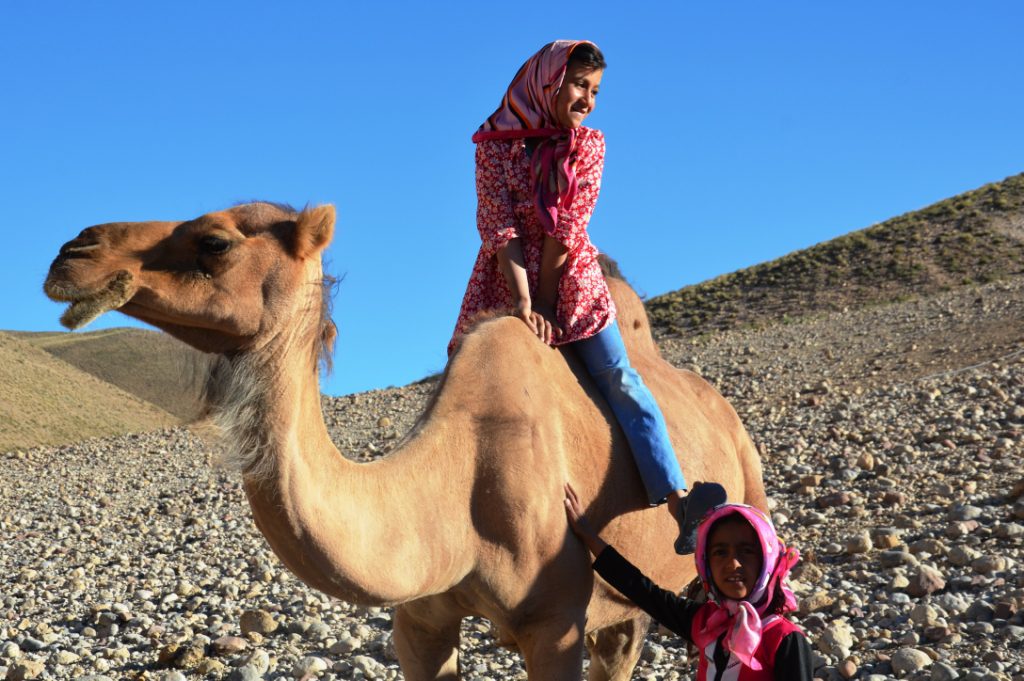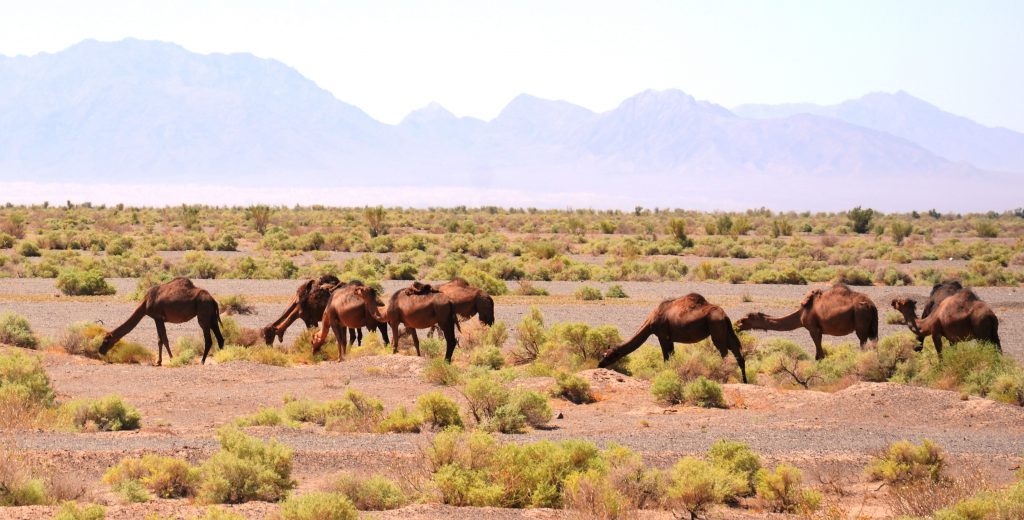
“Our camel culture has totally changed“, laments Mr. Muhammed Rabii with a wistful hint of a smile. “We never ate camel meat earlier and my father refused to take it until the end of his days. We believed to kill a camel would make a person cruel. And we never used camel wool to weave rugs, only garments, because we thought it disrespectful to the camel to step on its hairs with our feet. But now camel breeding is all about meat production.”
Mr. Rabii, a tall and gaunt man in his fifties with a gentle but somewhat resigned demeanour is from the Torud camel breeding tribe. We are sitting under the shade of a big tree in Chojaam, a crumbling complex of mudbrick buildings in the middle of the desert in Iran’s Semnan Province. It’s an abandoned caravanserai from the times in which the camel was the only means of transportation, trade and communication over long distances. Now only a couple of rooms are used by three camel herders for sleeping and cooking. But in front of it is a huge water tank, almost the size of an Olympic swimming pool. It is filled to the brim with fresh water channeled to it from a nearby mountain range through qanats, Iran’s traditional covered irrigation system.
The pool is the watering point for about three thousand camels owned by 30 families of Mr. Rabii’s clan. The animals roam around the desert feeding on thorny low shrubs and return for drinking in 2-3 day intervals. Most of the people of the Torud tribe live in the town of Torud, about 30 km away. But they take turns managing the camels. “All Torud people are camel breeders”, Mr. Hassan Ameri, one of the three herders currently on rotational duty tells us. “Our families used to have more than 7000 camels. The numbers have decreased, but they still provide us with our basic livelihoods – enough to live on, although not enough for any extras or luxuries”. Then he adds “Soon I will sell ten camels to pay for my son’s wedding”.
When I ask how the importance of the camel has changed, Mr. Rabii breaks into a philosophic homily. “Before, the camel was everywhere and essential in all aspects of life. We needed it for the transportation of goods, for bringing the bride, and as an ambulance. It was involved in every celebration. When a caravan started, the camels were decorated elaborately and it was a time of excitement and happiness. The wool of the camel was used to make the aba (cloak) of the clergy. In the Koran, the camel is the only animal is put on the same level with humans. But since the car came, all this changed.
The current camel breeding system is minimum input. The camels feed themselves, cursorily supervised by a young man on a motorbike who tries to prevent them from harm on the highway to Torud and from being attacked by cheetahs and wolves, but with limited success. The losses due to accidents and predation are significant. But apart from these dangers it’s an ideal area for camels that thrive in the hot and dry climate. Once a year, the young male camels are caught and sold to the meat markets in Teheran, Semnan and elsewhere. In Iran, there is a lot of demand for camel meat which sells as the same price or higher as lamb, for 10,000 Toman (about 3 USD) per kg liveweight.
The camel breeders proudly point out that they do not fatten their camels with processed chicken manure as has become a wide-spread practice in Iran. Mr. Rabii strongly disapproves of such methods, emphasizing that camels need to roam around freely and are an essential part of the desert eco-system. Sitting down next to a prickly camel thorn he explains how the camels are pruning the dried parts of the plant and thereby stimulating it to branch out. He also points at places where camels have urinated and says that this is where new shrubs will germinate as soon as a few drops of rain will fall.

The traditional knowledge of Mr. Rabii and his camel breeding colleagues – result of astute observations on the relationship between camels and plants over generations – is supported by bona fide scientific research. Already in the 1960s, zoologist Hilde Gauthier Pilters studied the ecology of camels in the Sahara and, in a book published by the University of Chicago Press, came to the conclusion that their grazing behavior does not cause damage to desert vegetation, but instead nurtures the growth of its plants.
This knowledge does not seem to have filtered through to bureaucrats and officials sitting in government offices and deciding over rangeland policies. About 200 km north of Torud, close to Firuzkot, we visit the summer camp of three nomadic families from the Elikai tribe. They are shepherds but also keep a herd of about 40 camels – in excellent fettle, with bulky humps and no trace of mange, the parasitic skin disease that is the scourge of more humid camel breeding areas. Most of them are only half tamed, but one of them behaves more like a favourite pet than a farm animal, placidly allowing everybody to sit and pose on it.
The family seats us in their tattered army type tent which is surprisingly comfortable inside, the floor covered with rugs and big cushions to lean on, then ply us with glasses of tea served on a silver tablet and freshly baked flat bread still warm from the stove. Nobody is more hospitable than nomads living in isolated areas.
Two of the men, with sparkling eyes in their weather beaten faces, talk expansively about their camels and their affection for them. “We have seen others who have sold their camels, but they are not any happier than we are – on the contrary”, they say. “ But the Ministry of Forest, Rangelands and Watershed is telling us to stop keeping them. The officials say that camels are destructive to the rangeland vegetation.”
“Camels are very clever animals and they are the owners of the pasture. So they do not destroy anything as long as they can move around. They take only one or two bites, and then move on. In fact, now that there are fewer camels, the balance of the rangelands is being destroyed. The camel thorn has grown so high that the sheep can no longer eat it. And tamarisks die if they are not browsed upon.”
“They even tell us that we should sell our camels and that they will bring in camels from Australia. But good will that do? Already large numbers of camels are smuggled into the country for slaughter from India and Pakistan. This is dangerous, as they pass through our territories and bring in diseases.”
At a meeting of UNICAMEL, an association of camel herders from all over Iran, that is held in Azerbaijan, in the far northwest of Iran, I gain more insight into the minds of the bureaucrats that decide on rangeland policies. The meeting is hosted by the Shahsevan tribal confederacy, Turkish speaking nomads who herd sheep and traditionally used two-humped Bactrian camels to transport their belongings on the migration between summering and wintering grounds. It is organized with the help of CENESTA, an Iranian NGO that has a long history of supporting Iran’s 600 nomadic tribes – organized in 100 tribal confederacies – in various ways. The get-together takes place in an encampment, an oba, perched on a slope with a magnificent view of the snow-covered volcanic Mount Savelan.
Members of UNICAMEL from all four corners of Iran hold forth about their woes, and officials from various government departments give speeches, with often vastly divergent views. I learn that as most of Iran is covered by deserts and steppes in which crops cannot be grown, nomadism has always been an important, even predominant way of life. Besides being providers of meat and dairy products, they made major contributions to its arts and crafts, notably its rug and carpet making traditions.
Unfortunately, under the Pahlevis, the dynasty that took over Iran at the beginning of the 20th century, the nomads were considered a threat. In the 1960s, the Shah declared the rangelands property of the state and the nomads were forcefully settled. While almost all policies were changed after the Iranian Revolution in 1978, the rangeland policy remained the same and until today bureaucrats decide about the dates on which nomads can move between their summer and winter pastures.
Iranian officials may want to keep camels off the range but, at the same time, they are eager to increase camel meat supply. Three years ago the government imported ten Bactrian male camels from China to cross them with the local one-humped camels because the hybrids reach significantly higher body size. Now they are planning to bring in 300 more in a swap for oil. Due to the embargo on Iran, the Chinese have not been able to pay for the oil they have obtained from Iran and instead sent compensation in kind, including camels.
The nomads also reported that large numbers of camels were being brought into the country from India – and that huge herds passed through their territories en route to slaughterhouses in Teheran. While Iranian officials did not confirm this, the nomads emphasized that such things could not happen without government connivance. They actually confirmed what I had heard earlier from reliable sources in Pakistan and India: large numbers of camels cross the Indo-Pakistan border in Kutch in Gujarat to reach their final destination in slaughter houses in Iran. This happens although this part of the Indo-Pakistan border is supposed to be sealed by a strong fence and although the camel was recently declared state animal with its export and slaughter banned in the Indian state of Rajasthan.
Disregard for nomads and their way of raising livestock is not limited to Iran, but similar thinking prevails in many countries. In China, Tibetan nomads are forcefully settled in order to protect the rangelands, leading to their economic destitution and dependence on hand-outs from the government. In India, camel nomads are systematically excluded from their summer grazing grounds in forests, while at the same time not being allowed to either sell their milk nor dispose of them for meat.
It is difficult to understand what is behind the contradictory policies of Asian countries versus the camels, and nomads in general. Why would Iran bring in camels from Australia instead of supporting its own camel breeders? Why does China sedentarize Tibetan nomads for “environmental protection” when nomadism is recognized as a means of conserving nature elsewhere? How can Rajasthan expect to save the camel when neither its products can be sold nor a place for camels to graze? Sometimes I wonder whether this is just incompetence or an intentional effort to promote industrial livestock production.
Nevertheless, Happy Camel Day 2016, and many thanks to its active promoters, especially Dr. Abdul Raziq Kakar!

 Follow
Follow